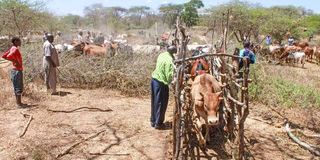Premium
What to do when lumpy skin disease hits your animals

An animal health service provider vaccinates cows against lumpy skin disease in Kilungu village, Makueni County, on February 28, 2019. Animals should be vaccinated once a year.
Limping cattle is a common problem in dairy farming. I narrated last week how one of my heifers started limping on all four legs overnight. The problem was caused by a viral disease called ephemeral fever or three-day-sickness.
Fortunately, most cases of the diseases recover uneventfully within about three days with or without treatment. Such diseases are said to be self-limiting.
This week again, Francis my farmhand, reported another heifer limping on the left hind leg. He thought it was the same disease as the previous one. In medicine, we call such disease determination diagnosis by rote.
This means diagnosing a disease because the signs shown resemble the ones seen in another patient previously. It is a highly discouraged method of diagnosis for different diseases share signs.
However, a trained eye will know the signs that are common to a group of diseases or conditions and the few signs that are specific to a particular illness.
For instance, many farmers report chicken being dull, have ruffled feathers, closing eyes and diarrhoea.
Such a description would not be useful to a doctor in diagnosing the problem because there are many chicken diseases with the same signs.
But when a doctor examines the bird physically and does some post mortem examinations, she is able to see signs such as the diarrhoea being green, chocolate, chocolate with blood streaks or yellow.
At post mortem, the doctor would also see the internal organs affected by the disease and how the illness effects look like. Therefore, it is a combination of unique disease signs that helps the doctor to make a fairly accurate diagnosis rather than just the obvious signs.
I usually tell farmers that diagnosing a disease by rote is like trying to guide someone to a location in the streets of Nairobi and telling them they will know the place when they see an M-Pesa stall.
I told Francis I would check the heifer once I got to the farm later in the day. Once I arrived, I observed the animal from a distance and saw it was feeding well. The face was bright and the body looked normal.
When the animal moved, I noted the limp on the left hind leg. It was limping from the joint below the heel.
The heifer was able to put quite some weight on the affected leg but would lift the leg if made to move fast.
I instructed Francis to put all the animals in the crush because I wanted to diagnose pregnancies and vaccinate the cows against foot and mouth disease. Once the animals were restrained, I examined their legs.
I found the limping heifer had a swollen lymph node at the base of the leg. The lower leg was swollen from the hoof joint to the area below the hock joint.
The hock is the joint that many people confuse with the animal’s knee. It is the joint below the udder.
I noticed the swollen section of the leg had two fresh wounds that oozed dilute blood and some clear fluid. I observed another heifer with the same kind of wounds at the same location on the right leg. Both animals were eating well and did not seem bothered much by the swelling and the wounds.
I concluded the animals had a mild form of lumpy skin disease or LSD. It is caused by a pox virus that is spread by mosquitoes and biting flies.
The disease is easily prevented by vaccination once a year. It mainly occurs in the rainy season when fly populations are high.
LSD vaccine is readily available in Kenya. I have vaccinated my cattle every year for the last five years without fail.
While two or three animals have shown the mild form of the disease every year, I have been spared full or even moderately severe disease even when cows in the area have shown full-blown disease.
This means the vaccine has been effective in inducing immunity in my cows.
My experience with LSD in vaccinated cattle is that it may cause swelling of the whole or part of a leg. The virus damages the walls of lymphatic vessels and causes fluid to ooze into the tissues.
Infected immune cattle will drop slightly in milk yield. Some have low grade fever while others may have some very small round swellings on the skin. The effects of the disease in vaccinated animals may last two to three days but the appetite is not affected.
In unvaccinated cattle, LSD causes large round raised swellings in the skin and mucous membranes with very high fever of up to 41 degrees Centigrade.
Deaths may be high, especially among calves. There is no specific cure for the disease but some antibiotics are known to improve the chances of recovery.
I treated my limping heifer with antibiotics and anti-inflammatory drugs to prevent infection of the wounds and reduce swelling.
I chose to leave the second heifer to heal without medication because the damage to the leg and other effects of the infection appeared to be waning.
It is good practice to only use medication when it is extremely necessary.





